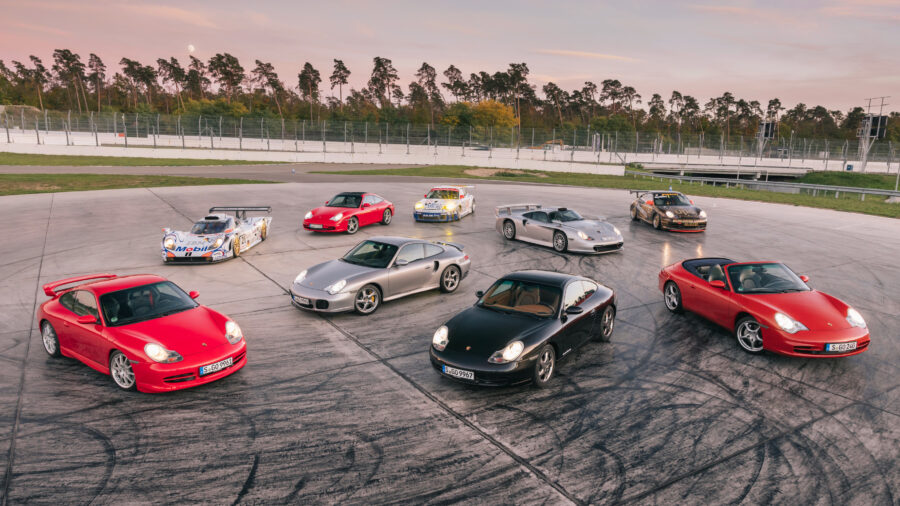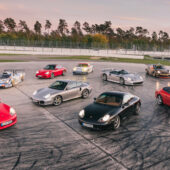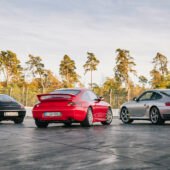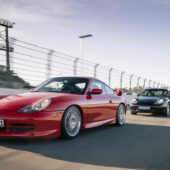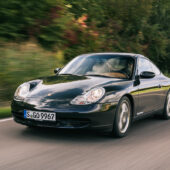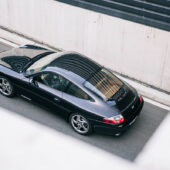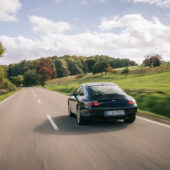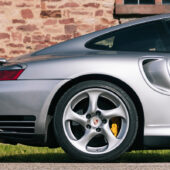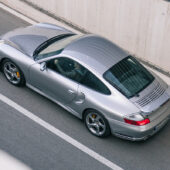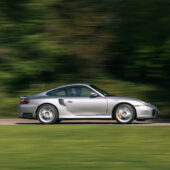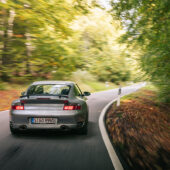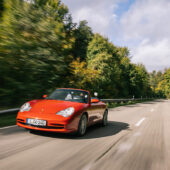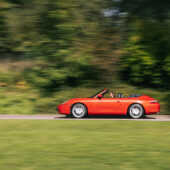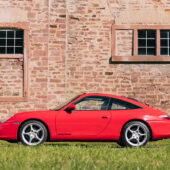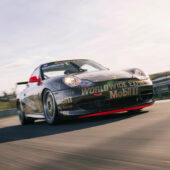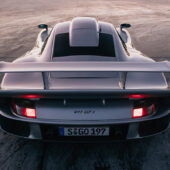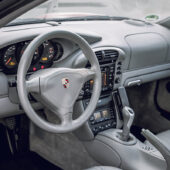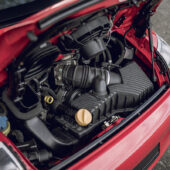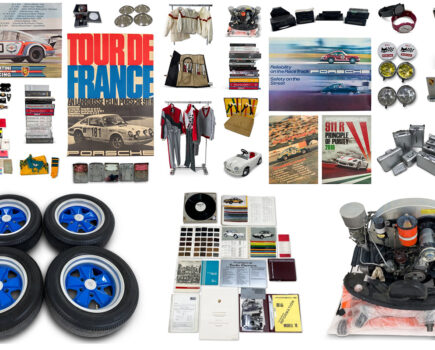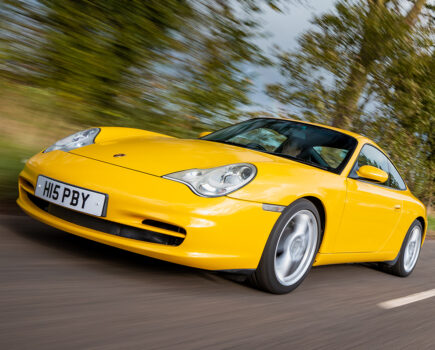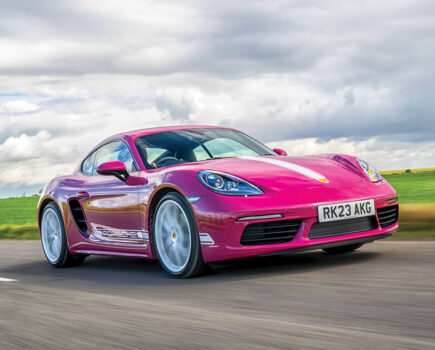The 911 gained a water-cooled engine for the first time in its 996 generation, along with a new bodyshell and mid-engined Boxster stablemate
Words: Jon Burgess Images: Porsche
It is easy to forget how close Porsche came to bankruptcy in the early 90s. Steeped in road and track tradition that older marques would have killed for, it found itself stymied by the very legacy it had traded on to date.
The 911 was, at a stroke, Porsche’s source of strength and, simultaneously, its greatest weakness. Other models (namely the transaxle cars) failed to replace the 911 outright, but the 911 itself was in need of an update. Its body could trace its roots back to the 1963 901/911; the latter 964 and 993 were, in effect, heavy iterative upgrades. A 1960s bodyshell with no more room for improvement, with a seminal air cooled engine at the mercy of emissions legislation. What was Porsche to do? To the horror of some purists, this meant everything had to go.
Porsche knew it could not rely on the 911 alone; a cheaper model, properly marketed, could replenish the coffers without denigrating the 911. It had worked before with the 914 – Porsche had gone mid-engined in the late 60s to great acclaim (and strong US sales). That car had borrowed the 911’s flat-six to cement its place among enthusiasts as the short-lived 914-6; the 1965-1969 912 and 1976 912E had lent 356 and VW flat-fours to bring entry-level buyers into the fold.
The Boxster (986), the new junior Porsche, had the same job but under the skin the relationship between it and the new 996 would run far deeper than ever before. In the past, the 924/944/968 transaxle range had shared parts but they were separate from the 911.
Porsche, however, had to stretch its investment. That the Boxster was a roaring success more than vindicated management’s decision; critics, however, would take time to warm to the 996.

Designed by Pinky Lai, the 996’s body was wider, longer and heavier than the 993 it replaced – in detail, it owed much to the still-born 989 four-door saloon. The 996 was to have round headlights like the 993 and 989, but cost restrictions and a shared development cycle with the Boxster meant that its ‘fried egg’ headlights were shared. Grant Larson’s 997 successor would redress the balance, giving the 911 back its round-eyed visage.
Obviously, the 996 remained rear-engined; while its front end shared much with the 1996 Boxster (wings, bonnet, headlights), bespoke rear suspension kept power from the new water-cooled M96 engine on the road.
In crude terms, the 996 was its own car beyond the dashboard; a more rakish windscreen angle further altered the classic 911 profile. The 996 shared its engine with the 986 too, although the cheaper car lost capacity in deference to the 911.
Four-valve per cylinder heads and a single spark plug per pot simplified the M96 in comparison to the outgoing classic ‘Mezger’ flat six, although that unit, named retrospectively after its co-creator, Hans Mezger, would be kept for the faster GT3, Turbo and GT2 models after heavy alteration.
At launch in 1998, the new Carrera 2 had 296bhp from 3.4-litres; while barely any more powerful than the outgoing 281bhp engine in the last 993s, the M96 was smoother, quieter, more fuel efficient, met future emissions requirements, and was far simpler to build in volume. The 986 made do with cast (rather than forged) pistons, smaller displacements (2.5-,2.7 and 3.2-litres) and smaller valvegear to differentiate it mechanically from the 996.
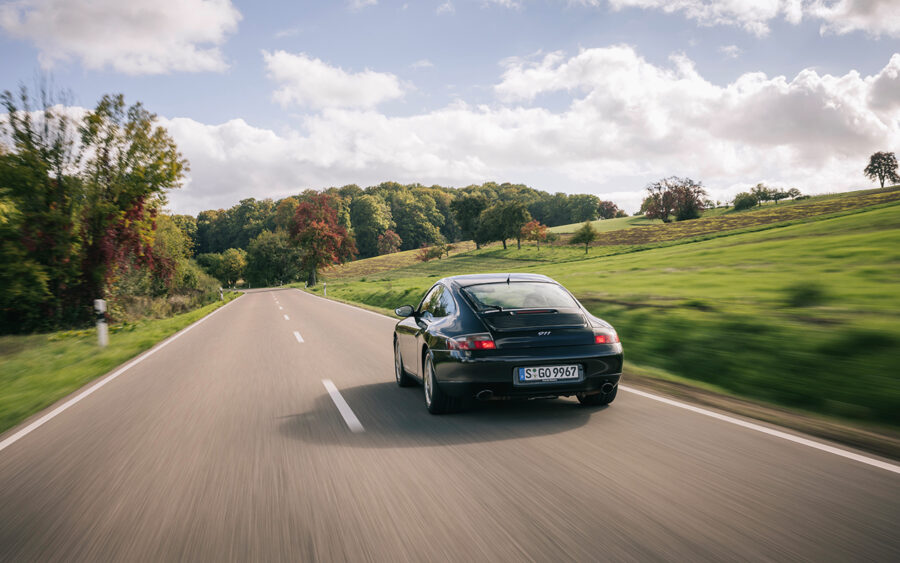
Enthusiasts came to rue Porsche’s cost-cutting measures in time – made all the more embarrassing through scorched cylinder fifth and sixth pots and intermediary shaft (IMS) bearing failures. Porsche’s own X51 ‘Powerkit’, comprising a baffled sump, stronger oil pump, better oil extraction and different pistons, addressed many of the oil starvation issues, with specialists fixing the other cars that went bang in time.
Still, it wouldn’t be until 1999 that the first of the so-called ‘Mezger’ engined 996s arrived – that being the lightened, faster GT3, whose 3.6-litre flat-six owed more to the 911 GT1’s engine than anything sat behind the axle of a Carrera 2 or Carrera 4. The GT3 did use the latter’s stiffer shell, however; while purists may have deemed the extra driven axle in the Carrera 4 superfluous, the two-wheel-drive GT3 made good use of its stablemate’s gutted unibody.
Tracing the evolution of the GT3’s ‘Mezger’ engine takes us back to the 962C Le Mans racer from which the 911 GT1 based its engine upon. When discussing ‘Mezger’ engines, we must consider Hans Mezger’s work in bringing the 911’s original 2.0-litre air-cooled engine to life, and that much later, unrelated and fully water-cooled 962 unit that Mezger also helped design.
The 993 brought the life of the first air-cooled Mezger unit to a close, while the 962C and 911 GT1 furthered the career of the second. Mezger’s work on the 917, 911 RSR and Type 935 must also be exemplified – but from where the GT3 is concerned, it took Mezger’s race engine, fresh from a 1-2 at the 1998 Le Mans 24 Hours, and civilised it for the road.
Not too far from the road, mind you: in the year of its launch, Walter Röhrl set a new road car lap record of 7 minutes and 56 seconds on the Nürburgring Nordschleife with a 911 GT3.

Porsche 996 GT3
Far stronger and more durable than the M96, the water-cooled Mezger engine suffered from none of that unit’s oil starvation issues and lacked the sealed intermediate shaft bearings that drove the camshafts. The Mezger flat six was called upon again for the 911 Turbo of 2000; with a pair of blowers installed, its power peaked at 414bhp.
The all-wheel-drive Turbo continued in the model’s tradition as a technical tour-de-force: its bi-xenon headlights with housed-in ‘teardrop’ covers were among the first ever offered on a road car. Buyers soon had the option of fitting composite brakes to their Turbo; Porsche Ceramic Composite Brakes (PCCB) saved 20kg of unsprung weight and reduced stopping distances even further.
PCCB made its first appearance in the 996 Turbo, and were fitted later on the fearsome V10 Carrera GT and 918 Spyder. A contemporary 911 Turbo option in every successor, they were discontinued in 2022 owing to high production and maintenance costs.
As was customary, the 996 Turbo also gained a wider body to house its larger tyres, suspension, panels, and running gear; it was a full 2.6 inches, or 65mm girthier than the other ‘narrowbody’ cars, the shell only used for the Turbo, the following year’s 462bhp GT2, and the 2002 Carrera 4S.
The year the 4S arrived was a busy one for the 996: a facelift (996.2) gave all cars the Turbo’s teardrop headlights; the M96 fitted in the Carrera 2, 4 and 4S went up to 3.6-litres and 316bhp; the only remnant of the 993 (its four-spoke steering wheel) was banished to history with a new three spoke tiller instead, and 996 buyers got a glovebox to use for the first time.
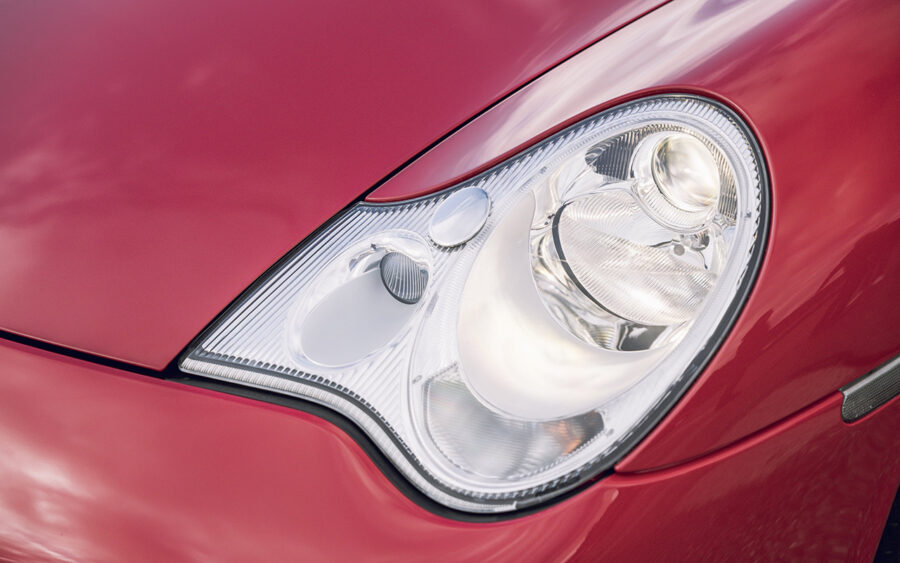
Finally, the last of the 996 variants arrived – the Targa. No longer based on the Cabriolet shell, as per usual, the 996 Targa began with a coupe body and added a sliding glass sunroof and a handy opening rear glass panel for rear seat access, creating, in effect, a 911 hatchback.
The final three years of the 996 further improved the breed. While the M96 failed to win over the die-hards, the Mezger water-cooled units went from strength to strength, cementing the more focused GT3, Turbo and GT2 as seminal models within the 996 bloodline.
2003 saw more power was extracted from the Mezger unit; in the Series 2 GT3 and GT3 Clubsport it peaked at 375bhp, whereas the GT2 and GT2 Clubsport now had 482bhp on tap.
40 years of the 911 were commemorated that year, too, with an appropriately named ’40 Jahre’ edition; running to 1963 cars, it was the only model to boast the X51 ‘Powerkit’ as standard, bar the third radiator. Like the 911-unit Millennium, special wheels and paint marked out the 40 Jahre: in place of the Millennium’s Violet Chromaflair was Carrera GT silver, never again used on a 996.
Having overcome much of the hostility that dogged its earlier years, the 996 continued to ascend for 2004, offering buyers Carrera 4S and Turbo Cabriolets in its twilight. An even more powerful all-wheel-drive Turbo, the 444bhp Turbo S, also went on sale. For that year, the GT3 RS sealed that model’s legend: effectively a Clubsport for the road, its carbon fibre fixed wing and racing shell seats blurred the distance between highway and circuit.
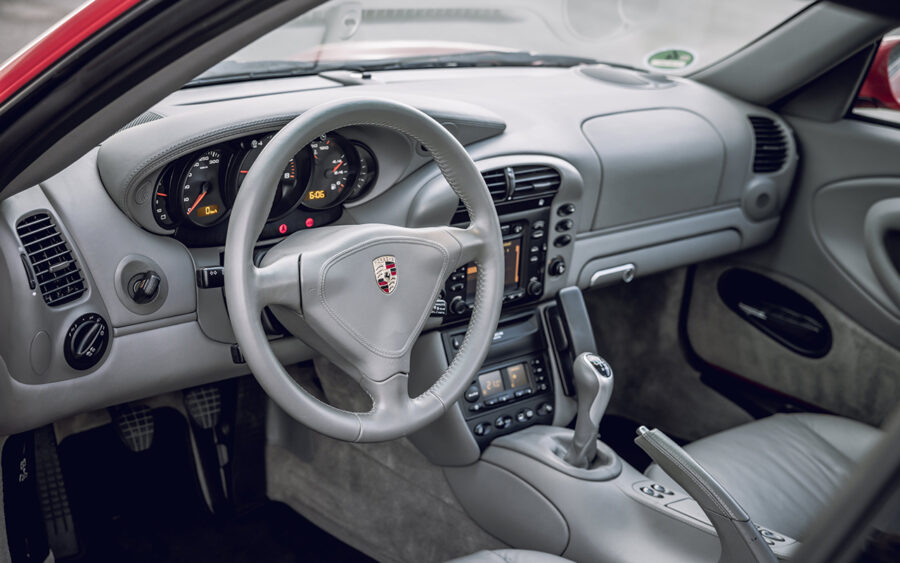
To no-one’s surprise, 997 models arrived in 2005 to replace the 996 Carrera 2 and 4; together with the Boxster, they had done their job and given Porsche the financial means to fight another day.
The M96 engine family would not last much longer, living until 2005 in base model 911 997s and until 2007 in the 987 Boxster. Other 996 models didn’t bow out until the end of the year, however. As the M96 cars were discontinued, the Mezger-engined Turbo, Turbo S, GT2 and GT3 carried on, earning their place in the 911 canon.
Change, as the 996 proved, was painful, but with its legacy secured, and the 911 safe, Porsche could finally look to the future – a future that made the misery of the late 80s and early 90s seem like a lifetime away.
Porsche 911 (996) timeline
1996
Boxster (986) launched, the entry-level Porsche that was co-developed with the 911 (996). Boxster debuts the new water-cooled, four-valves per cylinder M96 flat-six engine, in 2.5-litre guise.
911 GT1 debuts at 1996 Le Mans 24 Hours.
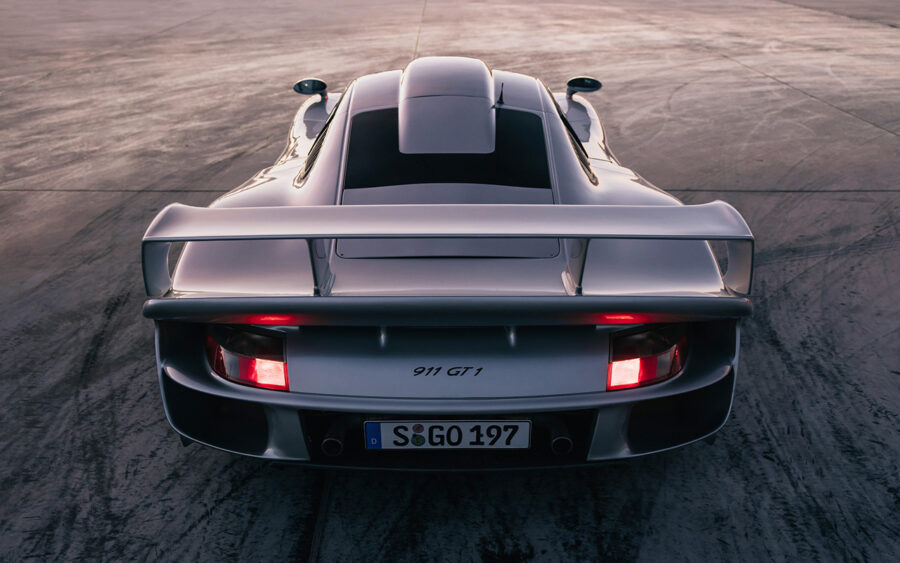
Porsche 996 GT1 Strassenversion
1998
911 (996) Carrera 2 debuts: 3.4-litre M96 water-cooled flat-six, six-speed gearbox, 296bhp. Only year of ‘fried egg’ orange indicators fore and aft. ZF-built Tiptronic also available from launch.
Cabriolet joins range in July that year.
911 GT1-98, now sharing the frontal treatment of the new 911 (996), won first and second place overall at the Le Mans 24 Hours.
1999
Carrera 4 arrives: all-wheel-drive with Porsche Stability Management (PSM), special 17-inch alloys and smoked indicators.
First ‘Mezger’-engined 996 unveiled at Geneva in June – the GT3, the direct successor to the 993 Carrera RS. 3.6-litres, 355bhp, front lip air dam, fixed rear spoiler and 18-inch alloys. Motorsport special GT3 Clubsport released alongside. 30mm lower suspension than Carrera models.
Reprogrammed Tiptronic with manual over-ride function.
911 GT1 withdrawn from GT racing.
2000
911 Turbo – also Mezger powered – launched. 414bhp, twin-turbos, all-wheel-drive, ‘teardrop’ bi-xenon headlights, 18-inch wheels, wider body, body kit, special bumpers and spoiler. Carbon fibre reinforced silicon carbide brake discs (PCCB) and Mercedes-Benz-built Tiptronic gearbox offered as options.
Special edition, Carrera 4-based Millennium debuts. Millenium-model specific Violet Chromaflair paint, tan leather interior, maple wood trim, numbered plaques, 18-inch chromed Turbo wheels.
PSM added as Carrera 2 option.

Porsche 996 Carrera Millennium
2001
Third Mezger-engined car on sale: two-wheel-drive, twin-turbo, manually adjustable, fixed wing 462bhp GT2, and GT2 Clubsport, the lightest road-going 996 to date. First generation of GT3 discontinued.
2002
Facelifted ’996.2’ released. Turbo teardrop headlights now used on all other models. Three-spoke steering wheel becomes standard across the range, along with a glovebox for the first time. Carrera 2 and 4 M96 engine receives a capacity increase to 3.6-litres; 316bhp now on tap.
Carrera 4S on sale; used wider Turbo body (minus ducktail spoiler), wheels and brakes but with Carrera 4 mechanicals.
Targa debuts: sliding glass roof and hatchback-style rear hinged glass with 316bhp, 3.6-litre M96 engine.
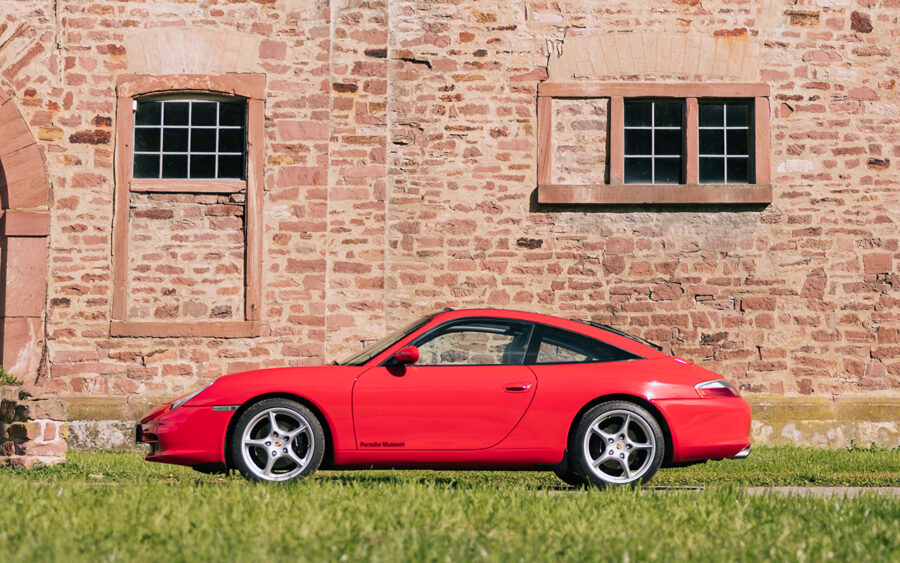
Porsche 996 Targa
2003
GT2 and GT2 Clubsport receive revisions; more powerful 483bhp Series 2 cars identified by yellow brake calipers but no further bodyshell work.
Upgrades to GT3 and GT3 Clubsport (Series 2). New 18-inch wheels, power up to 375bhp, redesigned fixed rear wing, Turbo teardrop headlights, red brake calipers, six-speed manual with limited-slip diff.
’40 Jahre’ edition, to commemorate four decades of 911 production shown at IAA Frankfurt. 1963 examples made; X51 engine package, Carrera GT silver paint, Turbo bumpers, fitted luggage and Carrera II alloys.
2004
Carrera 4S and Turbo models available as Cabriolets.
444bhp Turbo S released.
GT3 RS, a road-legal racing version of the GT3 put on sale. Racing seats, fixed carbon-fibre rear wing, roll cage; engine specification the same as the GT3 facelift. Built for 2004 only.
2005
Last year of 996; 997 successors replace Carrera 2 and Carrera 4 but Turbo, Turbo S, GT2 and GT3 produced until the end of 2005.

